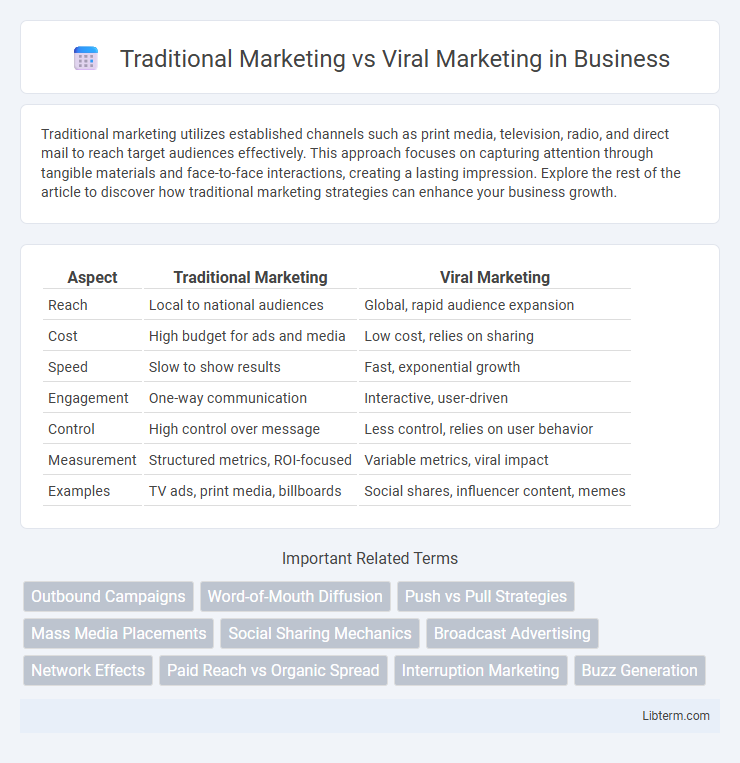Traditional marketing utilizes established channels such as print media, television, radio, and direct mail to reach target audiences effectively. This approach focuses on capturing attention through tangible materials and face-to-face interactions, creating a lasting impression. Explore the rest of the article to discover how traditional marketing strategies can enhance your business growth.
Table of Comparison
| Aspect | Traditional Marketing | Viral Marketing |
|---|---|---|
| Reach | Local to national audiences | Global, rapid audience expansion |
| Cost | High budget for ads and media | Low cost, relies on sharing |
| Speed | Slow to show results | Fast, exponential growth |
| Engagement | One-way communication | Interactive, user-driven |
| Control | High control over message | Less control, relies on user behavior |
| Measurement | Structured metrics, ROI-focused | Variable metrics, viral impact |
| Examples | TV ads, print media, billboards | Social shares, influencer content, memes |
Introduction to Traditional and Viral Marketing
Traditional marketing encompasses established strategies like print advertisements, television commercials, radio spots, and direct mail campaigns designed to reach a broad audience through conventional media channels. Viral marketing leverages digital platforms and social media networks to create highly shareable content that rapidly spreads peer-to-peer, generating exponential brand awareness with minimal advertising spend. Both approaches aim to influence consumer behavior, but viral marketing prioritizes organic growth and engagement driven by compelling storytelling and social sharing dynamics.
Key Differences Between Traditional and Viral Marketing
Traditional marketing relies on planned campaigns using channels such as TV, radio, print, and direct mail to reach a broad audience with controlled messaging. Viral marketing leverages social media platforms, user-generated content, and rapid sharing to create organic, exponential growth in brand awareness. Key differences include cost efficiency, audience engagement levels, and the speed at which messages spread, with viral marketing often achieving faster, more targeted impact through social proof and network effects.
Advantages of Traditional Marketing
Traditional marketing offers reliable brand visibility through established channels such as television, radio, print, and direct mail, reaching a broad and diverse audience. It provides measurable outcomes with consistent messaging that builds long-term customer trust and loyalty. This method ensures controlled communication, allowing businesses to tailor campaigns precisely to target demographics and regional markets.
Advantages of Viral Marketing
Viral marketing offers rapid brand exposure by leveraging social media platforms and word-of-mouth, enabling campaigns to reach millions at minimal cost. It capitalizes on user engagement and shareability, increasing the likelihood of message amplification and organic growth. Unlike traditional marketing, viral campaigns benefit from real-time audience feedback and higher credibility through peer recommendations.
Target Audience Reach and Engagement
Traditional marketing relies on broad channels such as TV, radio, and print to reach a wide but often less targeted audience, resulting in lower engagement rates. Viral marketing leverages digital platforms and social sharing to rapidly engage a specific target audience, driving higher interaction and organic reach. Data shows viral campaigns can achieve 6x more engagement per dollar spent compared to traditional methods, making them more effective for precise audience targeting and real-time feedback.
Cost Comparison: Traditional vs. Viral Marketing
Traditional marketing often involves high costs due to expenses related to print ads, TV commercials, and physical promotional materials. Viral marketing leverages social media platforms and word-of-mouth sharing, resulting in significantly lower budget requirements and higher return on investment. Businesses can achieve widespread brand exposure with minimal spending through viral campaigns compared to the substantial financial commitments needed for traditional marketing channels.
Measurability and Return on Investment
Traditional marketing relies heavily on broad metrics like reach and impressions, making precise measurability challenging and often resulting in less predictable return on investment (ROI). Viral marketing leverages social sharing and user engagement, offering clearer data points such as shares, clicks, and conversion rates that enhance measurability. The ROI of viral campaigns can be exponentially higher due to organic amplification, but it requires careful tracking through analytics tools to fully capture impact.
Creative Strategies in Both Approaches
Traditional marketing relies on carefully crafted creative strategies such as targeted advertising, branding, and consistent messaging to build long-term customer relationships through print, TV, and direct mail channels. Viral marketing emphasizes innovative, highly shareable content designed to trigger rapid organic spread via social media platforms and digital networks, leveraging emotional appeal and user participation. Both approaches require deep audience insights and creativity, but viral marketing prioritizes agility and real-time engagement while traditional marketing focuses on controlled, brand-consistent creativity.
Case Studies: Success Stories and Failures
Traditional marketing case studies, such as Coca-Cola's "Share a Coke" campaign, demonstrate consistent brand loyalty growth through personalized engagement and broad audience reach. Viral marketing successes, like the ALS Ice Bucket Challenge, highlight rapid, organic content sharing that boosts awareness and fundraising but can falter without sustained strategy, as seen in Pepsi's failed Kendall Jenner ad. Analyzing failures alongside successes reveals that viral marketing demands timely relevance and audience authenticity, whereas traditional marketing benefits from controlled messaging and long-term brand equity.
Choosing the Right Approach for Your Business
Traditional marketing relies on established channels such as print, TV, and radio to build brand awareness and trust through consistent messaging. Viral marketing leverages social media and online platforms to create highly shareable content, rapidly increasing reach with lower upfront costs but less control. Businesses must evaluate target audience behavior, budget, and campaign goals to determine whether steady exposure or rapid, organic growth best suits their marketing strategy.
Traditional Marketing Infographic

 libterm.com
libterm.com